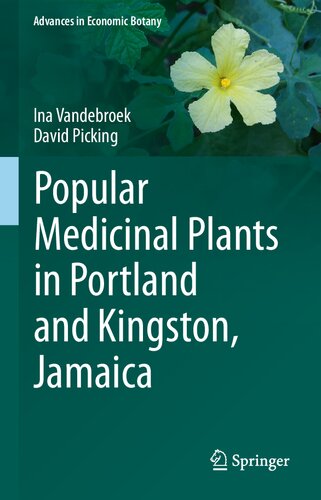

Most ebook files are in PDF format, so you can easily read them using various software such as Foxit Reader or directly on the Google Chrome browser.
Some ebook files are released by publishers in other formats such as .awz, .mobi, .epub, .fb2, etc. You may need to install specific software to read these formats on mobile/PC, such as Calibre.
Please read the tutorial at this link: https://ebookbell.com/faq
We offer FREE conversion to the popular formats you request; however, this may take some time. Therefore, right after payment, please email us, and we will try to provide the service as quickly as possible.
For some exceptional file formats or broken links (if any), please refrain from opening any disputes. Instead, email us first, and we will try to assist within a maximum of 6 hours.
EbookBell Team

4.4
92 reviews
ISBN 13: 9783030489267
Author: Ina Vandebroek, David Picking
This book highlights the results from over a year of ethnobotanical research in a rural and an urban community in Jamaica, where we interviewed more than 100 people who use medicinal plants for healthcare. The goal of this research was to better understand patterns of medicinal plant knowledge, and to find out which plants are used in consensus by local people for a variety of illnesses. For this book, we selected 25 popular medicinal plant species mentioned during fieldwork. Through individual interviews, we were able to rank plants according to their frequency of mention, and categorized the medicinal uses for each species as “major” (mentioned by more than 20% of people in a community) or “minor” (mentioned by more than 5%, but less than 20% of people). Botanical identification of plant specimens collected in the wild allowed for cross-linking of common and scientific plant names. To supplement field research, we undertook a comprehensive search and review of the ethnobotanical and biomedical literature. Our book summarizes all this information in detail under specific sub-headings.
1. Introduction
2. Aloe vera (L.) Burm.f. (Asphodelaceae)
3. Annona muricata L. (Annonaceae)
4. Antigonon leptopus Hook. & Arn. (Polygonaceae)
5. Argemone mexicana L. (Papaveraceae)
6. Artocarpus altilis (Parkinson) Fosberg (Moraceae)
7. Bryophyllum pinnatum (Lam.) Oken (Crassulaceae)
8. Chromolaena odorata (L.) R.M.King & H.Rob. (Asteraceae)
9. Citrus × aurantium L. (Rutaceae)
10. Clinopodium brownei (Sw.) Kuntze (Lamiaceae)
11. Cocos nucifera L. (Arecaceae)
12. Crescentia cujete L. (Bignoniaceae)
13. Cymbopogon citratus (DC.) Stapf (Poaceae)
14. Dysphania ambrosioides (L.) Mosyakin & Clemants (Amaranthaceae)
15. Eryngium foetidum L. (Apiaceae)
16. Jatropha gossypiifolia L. (Euphorbiaceae)
17. Momordica charantia L. (Cucurbitaceae)
18. Morinda citrifolia L. (Rubiaceae)
19. Petiveria alliacea L. (Phytolaccaceae)
20. Pimenta dioica (L.) Merr. (Myrtaceae)
21. Ricinus communis L. (Euphorbiaceae)
22. Senna alata (L.) Roxb. (Fabaceae)
23. Senna occidentalis (L.) Link (Fabaceae)
24. Solanum torvum Sw. (Solanaceae)
25. Turnera ulmifolia L. (Passifloraceae)
26. Zingiber officinale Roscoe (Zingiberaceae)
plant shops in portland oregon
medicinal plants pnw
invasive plants in portland oregon
common medicinal plants of portland jamaica
popular food in portland
popular medicinal herbs
Tags: Ina Vandebroek, David Picking, Medicinal, Plants